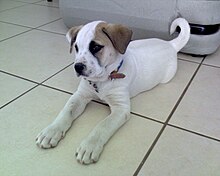History
In the late 19th century to early 20th century, two clubs were formed for the specific purpose of registering APBTs: the United Kennel Club and the American Dog Breeders Association. The United Kennel Club was founded in 1898, and was the first registry to recognize the breed, with the owner assigning the first number to his own APBT.[2]
The dog was bred first to bait bulls and bears.[3] When baiting bulls was deemed inhumane, ratting (a sport where a number of rats were placed in a pit for a specified time with the dog) and dog fighting became more popular. The APBT was used in both sports, and its prevalence in being put in pits with rats, or other dogs led to "pit" being added to its name.[4] With time, the dogs became more commonly domesticated due to their loyalty, loving and gentle nature with their owners.[5] In America, farmers and ranchers used their APBTs for protection, as catch dogs for semi-wild cattle and hogs, to hunt, and to drive livestock.[6] The dog was used during World War I and World War II as a way of delivering messages on the battlefield.[5]
Though of the same family, the American Pit Bull Terrier diverges in appearance from the Staffordshire Bull Terrier, having fewer bulldog traits in the face and body. The American Pit Bull is medium sized, having a short coat and smooth well-defined muscle structure, but should never appear bulky or muscle-bound. Its eyes are round to almond shaped, and its ears are small to medium in length and can be natural or cropped. The tail is slightly thick and tapers to a point. The coat is glossy, smooth, short, and slightly stiff and can be any color.[1] The breed ranges from a height of about 17 to 22 in (43 to 56 cm) at shoulders, females weigh between 30 and 50 lb (14 and 23 kg) and males weigh between 30 and 60 lb (14 and 27 kg).[2]
Temperament
The UKC gives this description of the characteristics of the American Pit Bull Terrier:The essential characteristics of the American Pit Bull Terrier are strength, confidence, and zest for life. This breed is eager to please and brimming over with enthusiasm. APBTs make excellent family companions and have always been noted for their love of children. Because most APBTs exhibit some level of dog aggression and because of its powerful physique, the APBT requires an owner who will carefully socialize and obedience train the dog. The breed’s natural agility makes it one of the most capable canine climbers so good fencing is a must for this breed. The APBT is not the best choice for a guard dog since they are extremely friendly, even with strangers. Aggressive behavior toward humans is uncharacteristic of the breed and highly undesirable. This breed does very well in performance events because of its high level of intelligence and its willingness to work.[7]Recently, American Pit Bull Terriers have been banned from several cities and counties, due to the general public's belief that Pit Bulls are naturally violent and aggressive towards people and other dogs. Contrary to popular belief, Pit Bull Terriers can be just as loving, caring, and loyal as any other dog breed. After further inspection, most deadly incidents involving Pit Bulls occur because of the manner in which the canine in question had been raised. Almost all of the fatal incidents involve Pit Bulls that had been trained for dog fighting. They are popular in the dog fighting world not because of their attitude or nature, but because they are an extremely strong breed of dog.[8]
Health
| This section requires expansion. (November 2009) |
They are very prone to Demodex Mange due to their short coat. There are two different types of Demodex Mange, namely Localized and Generalized Demodex. Although it is not contagious it is sometimes difficult to treat due to immunodeficiency in some puppies. The Localized symptoms are usually lost of hair in small patches on the head and feet of the puppies. This type will usually heal as the puppies grow and their immune systems are stronger. The second type which is Generalized Demodex mange is a more severe form of the sickness. The symptoms are more severe and include loss of hair throughout the entire body and may also be scabby and bloody. Generalized are usually hereditary due to immunodeficiency genes that are passed on from Sire and Dam to their puppies. A simple skin scraping test will allow the vet to diagnose if the dog has demodex mange. The most widely used method to treat Demodex Mange is ivermectin injections or oral medications. Since Demodex Mange lives in the hair follicles of the dog, Ivermectin will kill these mites at the source.[13]www.pitbullbreeders.webs.com



No comments:
Post a Comment
Note: Only a member of this blog may post a comment.